- Author: Kathy Keatley Garvey
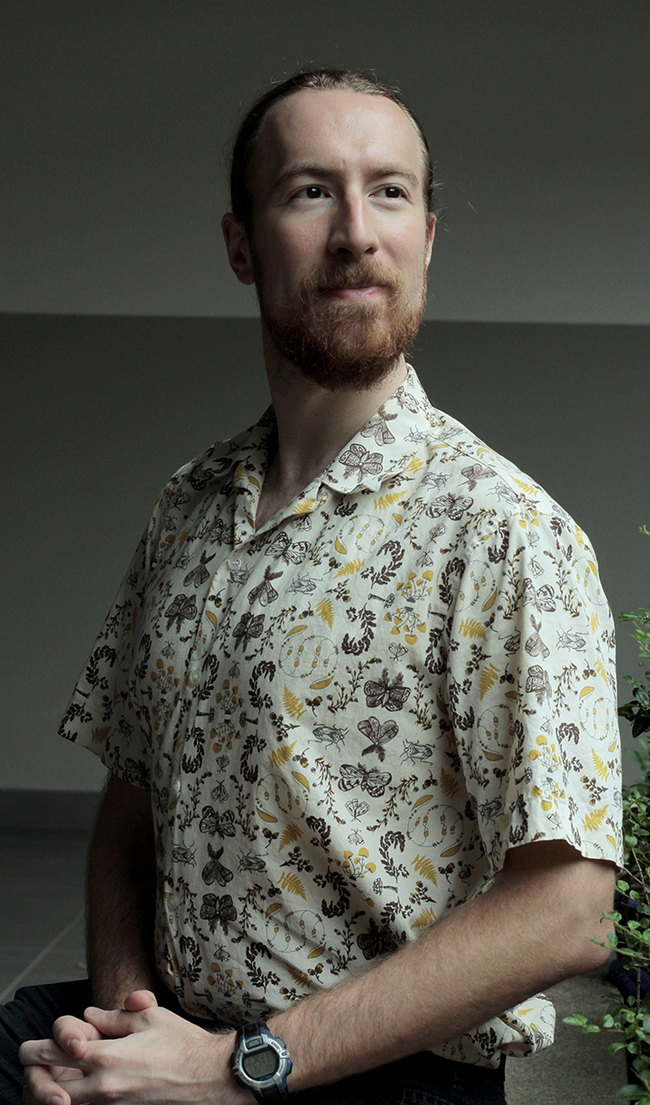
Meet Chryseobacterium kimseyorum, named for UC Davis distinguished professor Lynn Kimsey, director of the Bohart Museum, and her husband, forensic entomologist Robert "Bob" Kimsey, both of the Department of Entomology and Nematology.
“We've had a few things named after us but never bacteria--that's a first,” said Lynn Kimsey.
The story begins more than a decade ago when then UC Davis doctoral student Matan Shelomi, now an associate professor of entomology at National Taiwan University, Taiwan, was studying the digestive physiology of the stick and leaf insects, Phasmatodea, for his Ph.D, under the guidance of his major professor, Lynn Kimsey. He isolated and cultured bacteria from the guts and cages of the stick insects. Some of the species seemed new to science, but Shelomi had neither the time nor the resources to prove it then.
He stored the microbes inside the deep freezers of the Phaff Yeast Culture Collection, UC Davis Department of Food Science and Technology.
The years slipped by. So did the memory of isolating the bacteria. Then after becoming a professor himself, his graduate student, Chiao-Jung Han, discovered a new bacteria species inside a beetle. That prompted Shelomi to renew his interest in the microbes from the Bohart Museum.
"Thankfully, I kept all my notes from graduate school," says Shelomi, "so I was able to check and see which strains I had flagged as possibly new species. When I saw one of them was the same genus as the new microbe found in Taiwan, I realized this was an opportunity to describe them both together." So Shelomi emailed Kyria Boundy-Mills, curator of the Phaff Collection, “who had my old specimen revived and shipped across the Pacific.”
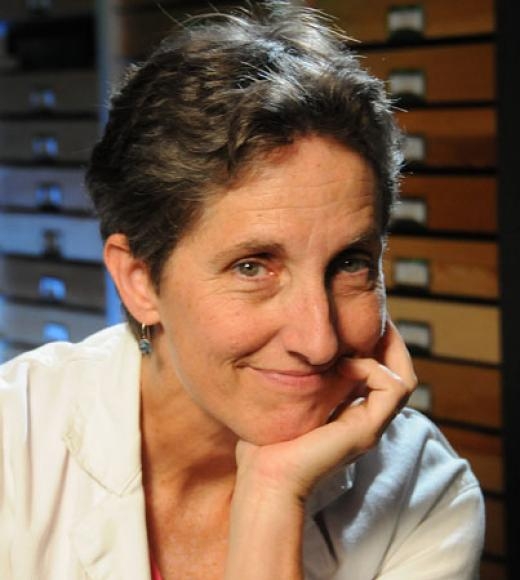
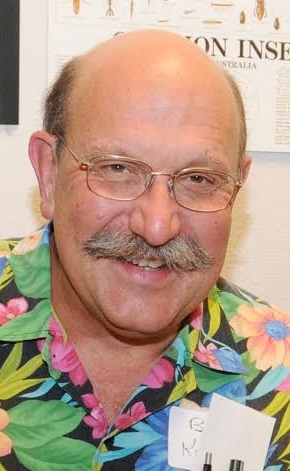
The abstract begins: “Two strains of Chryseobacterium identified from different experiments are proposed to represent new species. Strain WLa1L2M3T was isolated from the digestive tract of an Oryctes rhinoceros beetle larva. Strain 09-1422T was isolated from a cage housing the stick insect Eurycantha calcarata. Sequence analysis of the 16S rRNA and rpoB genes found both strains to be similar but not identical to other Chryseobacterium species. Whole-genome sequencing suggested the isolates represent new species, with average nucleotide identity values ranging from 74.6 to 80.5?%.”
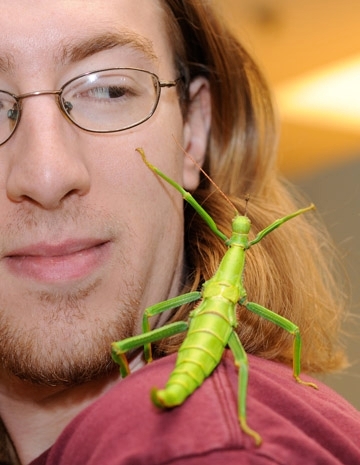
Tabatha Yang, education and outreach coordinator of the Bohart Museum, relayed the news to a tour group visiting the insect museum on April 20. “I just used this story today with a tour group,” she told Shelomi. “I mentioned how your student was denied her dog's name. I love how this ties the Bohart and the Phaff Yeast collection together and then California and Taiwan.”
As for the stick insect, “It's pretty aggressive for a walking stick,” Lynn Kimsey said, noting that Andy Engilis, curator of the UC Davis Museum of Wildlife and Fish Biology, told her about his work in Papua New Guinea. “These walking sticks would actually chase rodents out of their burrows and take over the burrows to rest in,” she related. “That's pretty tough for a walking stick.”
Meanwhile, the Kimseys are enjoying their new namesake. Lynn Kimsey already has seven other species named for her:
- Mystacagenia kimseyae Cambra & Wasbauer 2020 (spider wasp)
- Oligoaster kimseyae Soliman 2013 (tiphiid wasp)
- Exaerate kimseyae Oliviera 2011 (orchid bee)
- Spilomena kimseyae Antropov 1993 (solitary wasp)
- Manaos kimseyae Smith (argid sawfly)
- Spintharina kimseyae Bohart 1987 (cuckoo wasp)
- Neodryinus kimseyae Olmi 1987 (dryinid wasp)
Bob Kimsey has as at least two species named for him: Acordulacera kimseyi Smith, 2010 (sawfly) and Grandiella kimseyi Summers & Schuster (mite).
Shelomi, a Harvard University graduate who received his doctorate from UC Davis in 2014, served as a National Science Foundation postdoctoral fellow at the Max Planck Institute for Chemical Ecology, Germany for two years before accepting a faculty position in 2017 at National Taiwan University.
Shelomi returned to UC Davis in 2017 to present a seminar on "Revelations from Phasmatodea Digestive Track Transcriptomics,” to the department.

- Author: Kathy Keatley Garvey
NEWS BRIEF: April 8, 2014
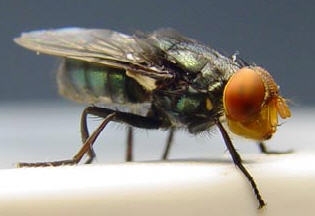
UC Riverside went on to win the championship, defeating Washington State University, Pullman, Wash. Both the winning team and the runner-up team will represent the Pacific Branch at the ESA meeting, Nov. 16-19 in Portland, Ore. The winning ream receives $500 to offset travel expenses. President of the ESA is integrated pest management specialist Frank Zalom, professor of entomology at UC Davis.
At the 2013 PBESA meeting, UC Riverside took first, and UC Davis, second.
The 2014 UC Davis team members, advised by Extension specialist Larry Godfrey of the UC Davis Department of Entomology and Nematology, who participated in the semi-finals were:
- Matan Shelomi, doctoral student who studies with major professor Lynn Kimsey
- Mohammad-Amir Aghaee, doctoral student who studies with major professor Larry Godfrey
- Rei Scampavia, doctoral candidate in the Edwin Lewis and Neal Williams lab
- Alexander Nguyen, an undergraduate student majoring in entomology who is an undergraduate researcher in the Bruce Hammock lab
- Alternate: Danny Klittich, doctoral student who studies with Michael Parrella (Klittich is also president of the Entomologiy Graduate Student Association (EGSA)
In the preliminary competition, Klittich served as a team member with Shelomi, Aghaee, and Nguyen.
The Linnaean Games is a lively question-and-answer, college bowl-style competition on entomology-based facts with four-member teams. Each must be in a degree program (bachelor's, master's or doctorate) or have completed a degree within one year of the contest.
Each team scores points by correctly answering a question posed by the moderator. There are two types of questions: toss-ups and bonuses, with each question worth 10 points.
One of the questions in the preliminary games: "Edward Knipling developed a new insect control technique. What was the insect he worked?"
Answer: "Primarily the screwworm fly with the sterile insect technique (SIT)."
Among the other questions asked of the various teams:
Question: What three hexapod orders comprise the "entognatha?"
Answer: Protura, Collembola and Diplura.
Question: Who is the current ESA President?
Answer: Frank Zalom
Question: What is the Arizona state Insect?
Answer: The two-tailed swallowtail butterfly, Papilio multicaudata
Question: Who wrote the poem "To A Louse," which opens with this stanza:
"Ha! whaur ye gaun, ye crowlin ferlie?
Your impudence protects you sairly;
I canna say but ye strunt rarely,
Owre gauze and lace;
Tho', faith! I fear ye dine but sparely
On sic a place."
Answer: Robert Burns.
UC Riverside correctly answered the Arizona state insect question in the UCR-WSU championship match. UCR also answered the entognatha question, although UC Davis knew the answer, too.
The Zalom question was asked during another two teams' match.
The Burns question was a bonus for UC Davis, but the team did not know the answer.
Related Links:
Results of 2013 PBESA Linnaean Games
2013 ESA Competition
2013 ESA Videos
- Author: Kathy Keatley Garvey
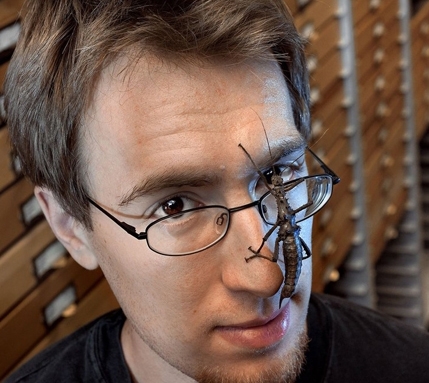
His abstract:
Shelomi received his bachelor's degree in organismic and evolutionary biology from Harvard University in 2009, and immediately after started his Ph.D program at UC Davis under Lynn Kimsey of the Bohart Museum.
His work in Davis is funded by the National Science Foundation's Graduate Research Fellowship program. He has also twice won the National Science Foundation's East Asia and Pacific Summer Institutes fellowship: once to work in the National Institute of Agrobiological Sciences in Tsukuba, Japan, and once to work in Academia Sinica in Taipei, Taiwan.
Shelomi served as a teaching assistant for Bob Kimsey's forensic entomology class, but also co-taught his own freshman seminar with Lynn Kimsey on "Evolution, Creationism, and Intelligent Design." He has given guest lectures for Entomology 10 "Natural History of Insects"; Entomology 100 "Introduction to Entomology"; and Entomology 102 "Insect Physiology."
He has presented at numerous meetings of the Entomological Society of America (ESA) and the Pacific Branch of the Entomological Society of America (PBESA) and also organized or co-organized four symposia at those meetings. He participates in the ESA's Linnaean Games and Student Debate teams. For his work with ESA and outside it, he won a John Henry Comstock Award in 2013. In addition, he has given a workshop at the 2012 International Conference on Science in Society, and received first place for his talk this past summer at the International Congress of Orthopterology in Kunming, China.
Shelomi's research has been spotlighted in the Sacramento Bee, California Aggie, DavisPatch, plus blogs and vlogs like LiveScience, PHD TV, and Breaking Bio. He also answers entomology and biology questions on Quora.com, where he has been a top writer for two consecutive years. His Quora answers have been posted to HuffPost and Slate. He won a "Shorty" social media award for his post "If you injure a bug, should you kill it or let it live?"
His publications from graduate school include:
M. Shelomi, W.C. Jasper, J. Atallah, L.S. Kimsey, B.R. Johnson. “How Sticks Eat Leaves: Re-evaluating Invertebrate Herbivory.” Manuscript Submitted for Publication.
M. Shelomi, H. Watanabe, G. Arakawa. (2014) “Endogenous Cellulase Enzymes in the Stick Insect (Phasmatodea) Gut.” Journal of Insect Physiology. 60: 25-30. doi: 10.1016/j.jinsphys.2013.10.007
M. Shelomi, L.S. Kimsey. (2013) “Vital Staining of the Stick Insect Digestive System Identifies Appendices of the Midgut as Novel System of Excretion.” Journal of Morphology. ePub before print. doi: 10.1002/jmor.20243
M. Shelomi. (2013) “Ants and the Humans Who Love Them in Bernard Werber's Les Fourmis Trilogy.” American Entomologist. 59(4): 208-213.
M. Shelomi, W-S Lo, L.S. Kimsey, C-H Kuo. (2013) “Analysis of the Gut Microbiota of Walking Sticks (Phasmatodea).” BMC Research Notes. 6: 368. doi: 10.1186/1756-0500-6-368. PMID: 24025149
M. Shelomi. (2013) “Mad Scientist: The Unique Case of a Published Delusion” Science and Engineering Ethics. 19(2): 381-388. doi: 10.1007/s11948-011-9339-2. PMID: 22173734
M. Shelomi. (2013) “Evidence of Photo Manipulation in a Delusional Parasitosis Paper.” Journal of Parasitology. 99(3): 583-585. doi: 10.1645/12-12.1 PMID: 23198757
M. Shelomi. (2012) “Where are we now? Bergmann's Rule sensu lato in Insects.” American Naturalist. 180(4), 511-519. PMID: 22976013
M. Shelomi, Andrew Richards, Ivana Li, Yukinari Okido. (2012) “A Phylogeny and Evolutionary History of the Pokémon.” Annals of Improbable Research, 18(4): 15-17.
M. Shelomi, L. Matern, D. Harris, J. Dinsdall, R. Kimsey. (2012) “DEET (N,N-Diethyl-meta-toluamide) Induced Delay of Blowfly Landing and Oviposition Rates on Treated Pig Carrion (Sus scrofa L.).” Journal of Forensic Science. 57(6): 1507-1511. doi: 10.1111/j.1556-4029.2012.
M. Shelomi. (2011) “Phasmid Eggs Do Not Survive Digestion by Quails and Chickens” Journal of Orthoptera Research. 20(2): 159-162. PMID: 22515377
M. Shelomi. (2012) “Book Review: Beetle Queen Conquers Tokyo.” Pan-Pacific Entomologist. 87(4): 300-301.M. Shelomi. (2011) “Phasmid Eggs Do Not Survive Digestion by Quails and Chickens” Journal of Orthoptera Research. 20(2): 159-162. PMID: 22515377
- Author: Kathy Keatley Garvey
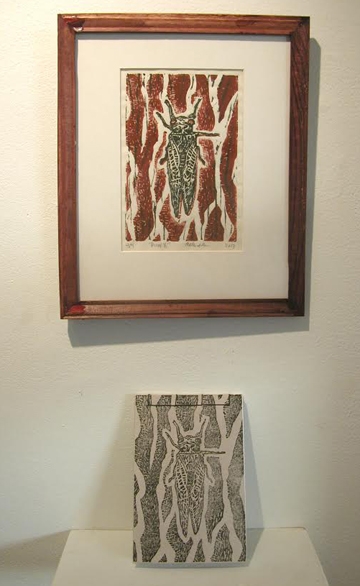
The exhibition includes bronze stick insects and a series of digital prints of colorful cockroaches.
The opening reception will be from 5 to 7 p.m. on Friday, Jan. 24. Shelomi will be there to answer questions. The gallery is located in the South Silo building.
Shelomi, who studies with major professor Lynn Kimsey, director of the Bohart Museum of Entomology and professor of entomology at UC Davis, has volunteered at the Craft Center since his graduate school enrollment at UC Davis in the fall of 2009. He has taken many of the evening and weekend classes offered there, from flame-working to wood-turning to bookbinding.
The most popular items are his bronze stick insects. Shelomi’s dissertation is on the digestive physiology of stick insects (Phasmatodea), for which he uses the many phasmids reared at the Bohart Museum for research and for public display.
How does he make the bronze replicas?
When a stick insect dies (of natural causes), Shelomi takes the hard exoskeleton to the Craft Center, mounts it with wax channels called “sprues,” and embeds it in plaster. He then heats the combination in a kiln until all organic matter, including the insect, is burned away, leaving a plaster mold with a cavity in the shape of a stick insect.
Shelomi then pours the molten metal, such as bronze or pewter, into the mold using a spin-caster machine. Each mold can be used only once, but the result is a metal copy of the insect with most of the details, from the spines to the delicate mouthparts, fully preserved.
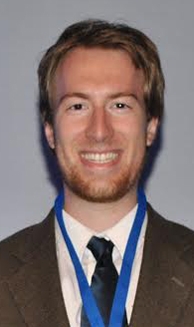
Another display in the exhibition is a series of digital prints of colorful cockroaches, from pinks to greens to blues. These were made by injecting some of the feeder cockroaches used in the Bohart Museum with histological dyes, a process known as “vital staining” that played a big role in Shelomi’s dissertation research. Each stain colors different tissues of the insect with different intensities, and can be used to identify anatomical features.
Other pieces include relief prints of cicadas, ceramic ants, and an oil painting of a Carabid beetle, as well as several works that are not entomology inspired, but showcase “the variety of media and materials one can work with at the Craft Center,” Shelomi said.
Some of the pieces at Shelomi’s solo exhibition will be available for purchase after the show. For more information, contact Matan Shelomi at mshelomi@ucdavis.edu.
Shelomi, active in entomological circles, received the 2013 John Henry Comtock Award from the Pacific Branch of the Entomological Society of America (ESA) and was a member of the UC Davis debate team that won the national 2013 ESA Student Debate championship. He regularly answers entomological questions on Quora.
The Craft Center, which offers more than 90 classes each quarter, is open on Thursdays from 12:30 to 10 p.m.; on Fridays from 12:30 to 7 p.m.; and on Saturdays and Sundays from 10 a.m. to 6 p.m. More information on the craft center is available on the website.
Related Links:
- Matan Shelomi and the Stick Insects
- Matan Shelomi's Shorty Award
- Cutting Bergmann's Rule Down to Size
- Taking a Poke at Pokemon
- NSF Grant
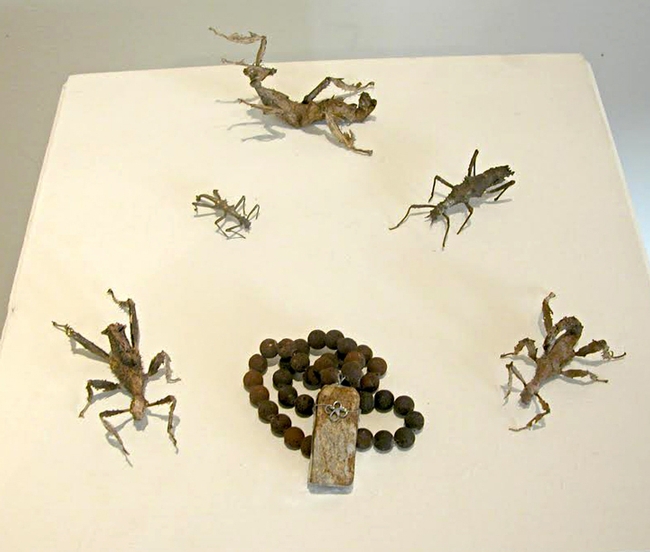
- Author: Kathy Keatley Garvey
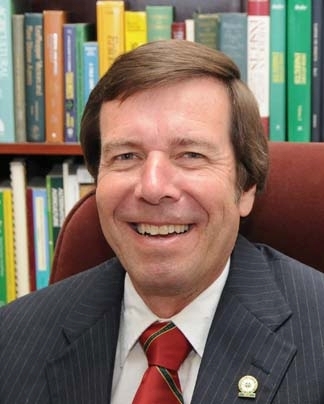
Zalom will be presiding over the 2014 meeting in Portland, Ore. His theme is "Grand Challenges Beyond Our Horizons." He will become the second UC Davis entomologist to head the international organization, which is comprised of members in educational institutions, health agencies, private industry and government. The first was Donald McLean, former professor and chair of the UC Davis Department of Entomology, who was elected ESA president in 1984. The department is now the UC Davis Department of Entomology and Nematology.
Some 3000 researchers, professors, graduate and undergraduate students, extension service personnel, administrators, research technicians, consultants, and others from around the globe gathered for four days of science, networking and fun, according to ESA spokesman Richard Levine. "This is the most important annual conference anywhere in the world for the science of entomology," he said, prior to the conference. The 2013 theme was “Science Impacting a Connected World."
Zalom has been heavily involved in research and leadership in integrated pest management (IPM) activities at the state, national and international levels. He directed the UC Statewide IPM Program for 16 years (1988-2001) and is currently experiment station co-chair of the Association of Public and Land-Grant Universities (APLU) National IPM Committee.
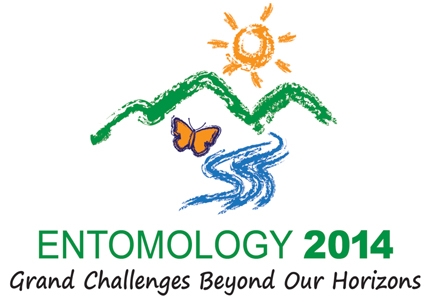
The IPM strategies and tactics Zalom has developed include monitoring procedures, thresholds, pest development and population models, biological controls and use of less toxic pesticides, which have become standard in practice and part of the UC IPM Guidelines for these crops.
In his three decades with the UC Davis entomology department, Zalom has published more than 300 refereed papers and book chapters, and more than 360 technical and extension articles. The articles span a wide range of topics related to IPM, including introduction and management of newer, soft insecticides, development of economic thresholds and sampling methods, management of invasive species, biological control, insect population dynamics, pesticide runoff mitigation, and determination of host feeding and oviposition preferences of pests.
The Zalom lab has responded to six important pest invasions in the last decade, with research projects on glassy-winged sharpshooter, olive fruit fly, a new biotype of greenhouse whitefly, invasive saltcedar, light brown apple moth, and the spotted wing Drosophila.
Zalom is a fellow of ESA, American Association for the Advancement of Science, and the California Academy of Sciences.
Highly honored for his work, Zalom received the Entomological Foundation’s 2010 “Award for Excellence in IPM,” an award sponsored by Syngenta Crop Protection and given for “the most outstanding contributions to IPM.” In 2008 he was was part of a team receiving an International IPM “Excellence Award” at the sixth International IPM Symposium. Also in 2008, Zalom was part of the seven-member UC Almond Pest Management Alliance IPM Team that received the Entomological Foundation’s "Award for Excellence in IPM.” Zalom was awarded the C. W. Woodworth Award from the Pacific Branch of the ESA in 2011.
Michael Parrella, professor and chair of the UC Davis Department of Entomology, served as the Pacific Branch’s representative to the ESA governing board for the past six years and will be succeeded on the board in 2014 by Douglas Walsh, professor at Washington State University who received his doctorate in entomology from UC Davis. Walsh received the "Excellence in IPM" award at 2013 meeting.
Zalom, Parrella and McLean are among 15 UC Davis entomologists elected as ESA fellows, an honor bestowed to a maximum of 10 persons per year. Richard Bohart (1913-2007), for whom the Bohart Museum of Entomology is named, received the honor in 1947, followed by Donald McLean, 1990; Harry H. Laidlaw Jr. (1907-2003), 1991; John Edman, 1994; Robert Washino, 1996; Bruce Eldridge, 2001; William Reisen, 2003; Harry Kaya, 2007; Michael Parrella and Frank Zalom, 2008; Walter Leal, 2009, Bruce Hammock and Thomas Scott, 2010; and James Carey and Diane Ullman, 2012.
At the Austin conference, Byrony Bonning, a former doctoral research associate at UC Davis in the Bruce Hammock lab who went on to become a noted professor in Iowa State University’s Department of Entomology and director of the National Science Foundation's Center for Arthropod Management Technologies, was inducted as an ESA Fellow.
Another UC Davis affiliate honored at the ESA meeting was Cornell University professor Anurag Agrawal, who received his doctorate in population biology from UC Davis while studying with major professor Rick Karban. He is the recipient of the Entomological Society of America’s 2013 Founders’ Memorial Award.
In addition, many UC Davis entomologists and graduate attended and presented their researech. See ESA schedule.
UC Davis doctoral candidate Matan Shelomi, who studies with Lynn Kimsey, director of the Bohart Museum of Entomology and professor of entomology at UC Davis, received the John Henry Comstock award (Pacific Branch). (See archived news story.) Shelomi captained the UC Davis Linnaean Team, which went to the finals, and also served on the UC Davis Debate Team. The Debate Team won the national championship.
The Debate Team, captained by Mohammad-Amir Aghaee and advised by Michael Parrella, also included graduate students Matan Shelomi, Danny Klittich and Irina Shapiro. The Linnaean Team, captained by Matan Shelomi and coached by Larry Godfrey, included Rei Scampavia, Jenny Carlson and Danica Maxwell.
For his 10-minute talk, Mohammad-Amir Aghaee received a first-place award in the President's Prize competition and Rosanna Kwok, a second-place prize. See news story.
See Frank Zalom's Video on Extending Orchard IPM Knowledge in California


